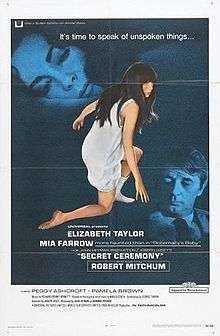Secret Ceremony
| Secret Ceremony | |
|---|---|
 | |
| Directed by | Joseph Losey |
| Produced by |
John Heyman Norman Priggen |
| Written by | George Tabori |
| Starring |
Elizabeth Taylor Mia Farrow Robert Mitchum |
| Music by | Richard Rodney Bennett |
| Cinematography | Gerry Fisher |
| Edited by | Reginald Beck |
| Distributed by | Universal Pictures |
Release dates | 1968 |
Running time | 105 min. |
| Country | United Kingdom |
| Language | English |
| Budget | $2,450,000[1] |
| Box office | $3 million (US/ Canada rentals)[2] |
Secret Ceremony is a 1968 film, produced in Britain and released by Universal Pictures. Based on the book by Argentine writer Marco Denevi, it stars Elizabeth Taylor, Mia Farrow, Robert Mitchum, Pamela Brown, and Peggy Ashcroft. Joseph Losey directed, from a script by George Tabori.
Plot
Leonora, a prostitute, is despondent over the death of her daughter. Cenci, a lonely young woman, follows Leonora to the cemetery and strikes up a conversation with her, inviting her home.
A resemblance to Cenci's late mother becomes obvious once Leonora notices a portrait. Cenci, who is 22 but looks and acts much younger, asks Leonora to stay. A lie is told to the housekeeper Hannah that Leonora is actually Cenci's aunt.
Cenci is found one day cowering under a table. Albert, her stepfather, has paid a visit. Cenci is terrified of him, claiming that as a child, Albert tried to seduce her. Leonora is repelled by the man's presence until Albert tells her that Cenci is mentally unstable and had repeatedly tried to seduce him.
On a beach one day, Cenci and Albert have sexual relations. A despondent Cenci commits suicide. At the funeral, Leonora now knows whom she chooses to believe. After standing beside Albert in silence during the burial, Leonora produces a knife and stabs him.
Reception
Critics
Some critics essentially maintained Secret Ceremony is a bad film yet one that can be enjoyed due to a certain camp quality evident in Losey's mise-en-scène and the actors' performances. Other analysts regarded the film as compelling because of its deep psychological portraits. Taylor's performance has been characterized as occasionally tacky, but justified by the fact that she is playing a prostitute and mother at the same time.
The chief set of the film, the house where Farrow lives, was Debenham House in London's Holland Park district. The house is a noted example of the Arts and Crafts style. Losey was famous for his so-called baroque style which he put to full use showing off the architecture of the set. For the scenes on the beach Losey chose a spot in Noordwijk, the Netherlands.
There are apparently varying versions of the film, the result of Universal Pictures' tampering with Losey's original cut, possibly to de-emphasize the lesbian aspects of the Taylor-Farrow relationship. Writer Harlan Ellison has noted in many articles that Universal Studios executives tend to savage their own films to the point of vandalism.
Cast
- Elizabeth Taylor as Leonora
- Mia Farrow as Cenci
- Robert Mitchum as Albert
- Peggy Ashcroft as Hannah
Production
The short story on which the film is based won a $5,000 prize in a competition run by Life en Espanol. It had already been filmed for Argentinean TV when it was optioned in 1963 by Dore Schary.[3]